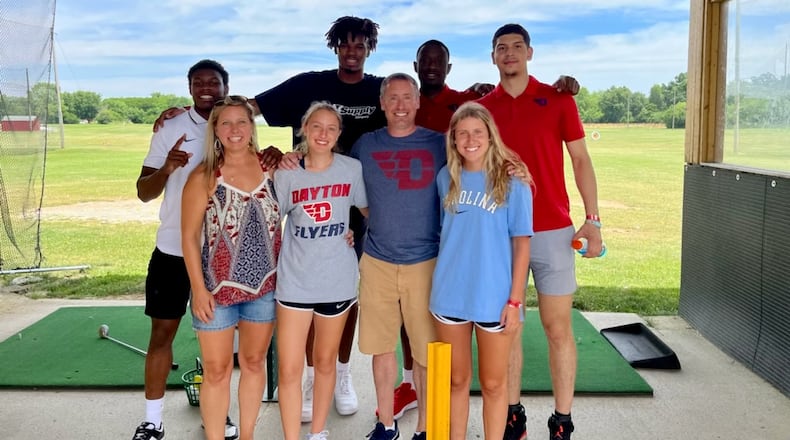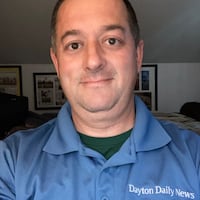That was just the start. A 24-win season full of big moments — last-second victories against Kansas and Richmond, for example — raised the profile of a number of Flyers. They have translated that on-court success into NIL opportunities. The UD administration has supported them throughout the process.
“We’ve doubled down on what we think we do best,” UD Athletic Director Neil Sullivan said in an interview earlier this month, “and what we think we do best is create a 360-degree student experience for our basketball players. When I meet with recruits, I tell them we are a boutique basketball firm. We offer specialized, personalized investment in them, and that has always been everything from academics to their performance on the court, and now NIL is a component of that. It’s not The Component, but it is a component.”
Sullivan sent an email about NIL to season-ticket holders and shared the same letter on Dayton’s website Wednesday. In it, he advised fans on how to engage with student-athletes and also commented on the current state of NIL at UD.
“Our student-athletes have earned legitimate income, with authentic work and appearance fees,” Sullivan wrote. “We have never asked or encouraged, directly or indirectly, any third party to be involved in the recruiting process. Boosters, fans and NIL agents have not been asked to communicate (e.g., call, text, direct message) with a recruit, their family or others affiliated with a prospect. The NIL deals have been legitimate and for work performed. International student-athletes remain limited in their ability to receive certain forms of NIL compensation by the terms of their visas and immigration status, but the international space continues to evolve.
“Please make no mistake, NIL is now one of the primary influences in the recruiting and retention process. Current and future players are observing how our community supports NIL, just as they evaluate our coaching, facilities, fan support, academic excellence, graduation rates, and overall quality of campus life. NIL is now an important part of the Dayton athletic experience.”
That experience started changing with the first endorsement opportunity provided by Roberts. It led to many more in the months that followed. Three Dayton players and three players from Wright State were paid to appear at the Catholic Social Services of the Miami Valley’s Centennial Celebration in September. In October, Dayton men’s and women’s players made money by appearing at a Fan Fest at UD Arena.
Forward DaRon Holmes II entered a paid partnership with Lee’s Famous Recipe in January. Then point guard Malachi Smith signed an endorsement deal with Hunny Bee’s Crispy Fried in February. Both Holmes and Smith have also sold T-shirts with their images. Smith and teammate Koby Brea are both on Cameo, a website where fans can arrange for actors, athletics, etc., to send personalized videos. Brea held a camp for kids from Dayton Metro Basketball.
R.J. Blakney has merchandise for sale on FansMeetIdols.com. Fans can also pay for him through the site to autograph photos, offer coaching advice through a video or to repost an Instagram story. A T-shirt company, BreakingT, partnered with Blakney on a “Blakney Called Game” T-shirt after his game-winning dunk against Richmond. Fans can also purchase shirts with the players’ names and numbers through the company.
Fifth Third Bank recently held an event for customers featuring Holmes, Smith, Brea and Blakney at UD Arena. The players worked with kids on the court. The I Supply Company, of Fairborn, held an event featuring the same four players at Young’s Jersey Dairy in Yellow Springs last weekend.
In July, Malachi Smith and his brother Scoochie Smith will hold a basketball camp for kids at UD. Holmes will hold his own camp at Sinclair Community College.
UD also announced in June it was one of the programs picked to partner with Topps and Fanatics for the “first-ever NIL trading card program, featuring college’s top athletes.”
Matt Farrell, the director of basketball operations at UD from 2006-11 and now a strategy and operations executive and entrepreneur in Dayton, has helped facilitate many of the NIL deals for Dayton athletes. Sullivan mentioned Farrell in his email as a point of contact for fans or companies looking to work with UD athletes
“The thing I would reemphasize is that everything we — we, as in the community — have done with these players has been under the true spirit and intent of NIL,” Farrell said. “Appearances, events, camps, clinics, individual workouts, whether it’s a kid’s birthday party or a corporate picnic.”
Farrell checks with players after their appearances and said they have enjoyed the experiences. A couple of their recent text message responses to him read simply, “Amazing,” and “That was so much fun.” The players profit from every appearance, but it’s not just about collecting a paycheck, Farrell said.
“It’s truly community engagement, community outreach in a way that they can be compensated for their time and energy,” Farrell said. “I love what we’ve done. It’s been really good. I think Neil Sullivan’s model from the beginning has always been, ‘What is sustainable and repeatable? What does this community want?’ And I think in year one we’ve checked a lot of boxes. Now that people understand what is possible, let’s find new ways. Let’s provide more opportunities.”
Sullivan said UD was supportive of the athletes gaining their new rights before the NCAA’s decision, but he was also wary of the “consequences of a mostly unregulated market.”
“Prior to the Supreme Court ruling and essentially (the NIL era coming) with very little regulation,” Sullivan said, “there really was an effort for it to genuinely represent payment for the use of name, image and likeness and not be just talent-acquisition fees, if you will. So the marketplace has ebbed and flowed since the beginning. We’ve seen seen things peak. It still continues to ebb and flow. I’m pretty satisfied so far with our players’ ability to market themselves in our community, and they’re certainly taking advantage of that, which I think is really critical. We’ll see where it all goes. We see opportunity in the market chaos.”
The first year of the NIL era has not come without issues. Alabama football coach Nick Saban accused Texas A&M of buying players in the spring by promising recruits name, image and likeness deals. More recently, according to reports, the NCAA has begun looking into NIL deals involving a Miami Hurricanes booster.
In response to worries about boosters essentially paying players to pick their schools with pre-arranged deals, the NCAA released new guidelines in May.
“Specifically, the guidance defines as a booster any third-party entity that promotes an athletics program, assists with recruiting or assists with providing benefits to recruits, enrolled student-athletes or their family members,” the NCAA announced. “The definition could include ‘collectives’ set up to funnel name, image and likeness deals to prospective student-athletes or enrolled student-athletes who might be considering transferring. NCAA recruiting rules preclude boosters from recruiting and/or providing benefits to prospective student-athletes.”
Five of Dayton’s 12 scholarship athletes can’t take advantage of their NIL rights because of rules regarding student visas. Toumani Camara (Belgium), Kobe Elvis (Canada), Mustapha Amzil (Finland), Richard Amaefule (England) and Mike Sharavjamts (Mongolia) are all international students. They can profit off their name, image and likeness when they are in their home countries. When Amzil returned to Finland in May, he announced his availability for potential deals on Twitter.
“I’ll be representing the Finnish National Team most of the summer,” Amzil wrote. “Since I am an international student-athlete and out of the country, I am now open to any business and sponsorship deals! I’d love to discuss some NIL deals with you. Let’s work!”
Camara has not been home in the last year and doesn’t plan to return home this summer.
“It’s frustrating, but I don’t really mind it because we’re seeing much how much stuff (his teammates) have to do,” he said. “They need to go to different places and sign contracts. I feel like it could be a distraction for a lot of people. Of course, it’d be nice to have more money, but it’s not something I need right now. So I’m not really complaining.”
Camara and men’s and women’s basketball players across the Atlantic 10 Conference will benefit this year by the league’s decision to provide academic bonus payments of $5,980 to every athlete.
This is related to the Alston decision by the United States Supreme Court, which last year ruled “the NCAA and its member colleges are suppressing the pay of student athletes who collectively generate billions of dollars in revenues for colleges every year. Those enormous sums of money flow to seemingly everyone except the student athletes. College presidents, athletic directors, coaches, conference commissioners, and NCAA executives take in six- and seven-figure salaries. Colleges build lavish new facilities. But the student athletes who generate the revenues, many of whom are African American and from lower-income backgrounds, end up with little or nothing.”
ESPN reported in April 22 of the 130 NCAA Football Bowl Subdivision-level schools planned to offer the payments. Dayton planned to offer the payments anyway before the league’s decision, Sullivan said.
“There was belief within the league that if everybody went that direction that would continue to signal investment in men’s and women’s basketball collectively,” Sullivan said. “We had been planning on that for some time. It was just a matter of working through the execution of it.”
About the Author



